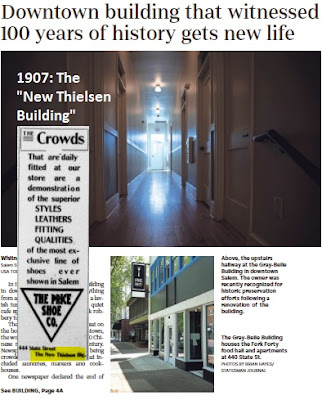Behind a couple of recent items in the paper, and related to another debate in the past year, are connections with the Thielsen family, who came here over a century ago with the railroads. Here are some notes, which may lead to further investigations.
 |
| May 4th, 1928 |
In the piece about walking every street in Salem, Ed Lazzara highlighted as his favorite a fascinating little pocket neighborhood. "...one section of Faye Wright did wow him. He described a wooded area off Welcome Way SE with large lots and extravagant homes."
 |
| Alderbrook is favorite |
The streets are these wide boulevards, often without sidewalks. They are really overbuilt! The lots are indeed large, and the tree canopy dense and in some places even a little majestic, at least by Salem standards. At least one realtor treats it as a distinct neighborhood.
Right at the 12th Street Cut-off there is an even larger lot that stands out for its size, the hiddenness of its house, and its age. It is some kind of estate that has remained at least partially intact while the city around it has been sold off and built up.
 |
| One especially old and large lot in Alderbrook |
Last summer, the owners filed for some lot changes, apparently to subdivide it further and sell off part of the estate, but they withdrew it, and it will likely reappear at some point. In preparation for that, you may recall, the City vacated a funny little remnant street, Vacation Lane. The interior lot and house was of interest then, and I think we can fill in some of the blanks.
Tentatively, I want to suggest that this large lot and house was the original "Alderbrook," a "country home," for prominent Salemites in the early part of the 20th century.
 |
| May 9th, 1925 |
The name Thielsen is of interest, also. Before it was known as the Grey-Belle building, 440 State Street was the "New Thielsen Building." Zinn's had one side, and a shoe store the other.
 |
| Before it was the "Grey-Belle," it was the "New Thielsen Building" Inset: September 26th, 1907 |
The Thielsen family made a small fortune off the railroads, and there will be more to say about them in another post. (Family papers are archived at the University of Oregon.) You may recall also the Simonton Overland business in a building partially concealed behind photos of the Oregon Electric. That brick building, now lost, at 151 North High Street was also built by the Thielsen family, and housed the Thielsen Cash Grocery for a while in the early 19-teens, after the Overland business left. The Thielsens sold it to F. G. Delano and Asa Eoff for the Salem Automobile Company in 1921.
The Thielsens also appear to have developed some or all of the greater Alderbrook subdivision. There is Alderbrook, Alderbook Manor, and Alderbrook Annex Nos. 1 and 2. A more detailed history of these might be interesting.
In the ads for Alderbrook exclusionary features are also mentioned. The ad at top calls out building restrictions and architectural control, links "better homes" with "happier homes," and this ad from a couple days later highlights "high class houses."
 |
| May 6th, 1928 |
 |
| April 10th, 1929 |
It's not entirely clear how long the Thielsens lived at Alderbrook. In 1934 an article suggests it had been mainly known as "the old Lansing property," and Fred Thielsen had lived there only a few years.
 |
| May 5th, 1934 |
The piece claims that
The large home upon the grounds was built more than 30 years ago by the Lansings. It contains two features which make it unique: seven tile fireplaces in the 10 rooms and a foundation built entirely trom stones found on the place and hewn by hand. Water for the premises is furnished by the same cold springs which supply the Graber camp grounds across the highway.
That lines up with the estimated date of 1901 for the house from the Assessor.
 |
| Advertorial for Lansing's Quaker Nursery on Garden Road, now Market Street (January 2nd, 1905) |
Since we associate the Lansings with north Salem and Lansing Avenue,
this possible connection in south Salem to that family may be worth more investigation.
The "Graber camp grounds" also sounds a little interesting.
Most interesting here, however, is a note about the IOOF Pioneer Cemetery in that same paper from May 6th, 1928. It argues for "a beautiful tree lined boulevard" between Fairmount and Candalaria "through the cemetery"! So this is evidence for historical interest in a connection through the cemetery.
 |
| May 6th, 1928 |
At the end of this note on a cemetery connection, they link the matter with the difficulties Charlie Maxwell was having trying to start a business in the Hollywood neighborhood, at least indirectly touching on the exclusionary and racist ends of zoning.
Back to the Thielsens, Fred Thielsen also was appointed to the Planning and Zoning Commission in October of 1929, and they are linked with a common sight on the bike ride to Rickreall. We'll come back to all that in another post.


No comments:
Post a Comment